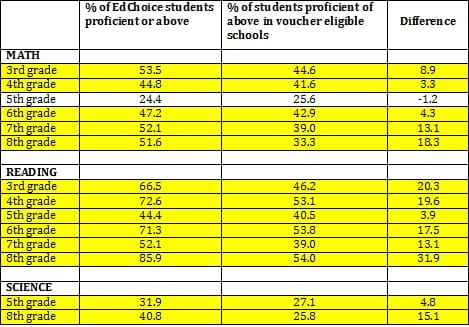Ohio currently has a basket full of publicly funded, private-school voucher programs, making it unique in America's school choice landscape. Ohio has three separate programs for students in failing districts, students with autism, and students living in Cleveland. A voucher program for students with disabilities launches next year. Further, the EdChoice Scholarship program (which provides private school scholarships for students in failing public schools) was recently expanded to 30,000 scholarships statewide this school year and 60,000 next year.
A new choice bill is now being debated in the House that would vastly expand the number of students eligible to receive a voucher. HB 136 would create the Parental Choice and Taxpayer Scholarship (PACT) Program and give children who come from families with annual incomes of up to $62,000 a year a voucher worth up to $4,563. Furthermore, 25 percent of families in the state could be eligible for smaller vouchers awarded on a sliding scale for families with incomes up to $95,000. This expansive growth in school choice options via vouchers is contentious to say the least.
A myriad of opinions offering both support and opposition to the expansion of vouchers have been voiced over the past several months (see Terry's recent op-ed here); however, one criticism in particular warrants a response. An October 12 Columbus Dispatch editorial, ?Many Questions,? stated that ?advocates should be able to show that students who go to private schools using vouchers do better than their peers who remain at the public schools they left. So far no one has collected such data.? While better data are certainly needed, what we have now is telling.
With the limited data available from the Ohio Department of Education (we can't get at value-added growth or growth over time) we are able to compare the academic performance of students using an EdChoice voucher to those students who remain in voucher-eligible public school buildings, on a single-year, snap-shot basis.??
The results for Ohio's ?Big 8? districts (from which the majority of voucher students hail) are encouraging for school-choice supporters. The chart below provides a one-year snapshot for the performance of EdChoice students in Columbus versus students in voucher-eligible district schools. Voucher students outperform their peers in every subject and grade except one, and in some cases do so by a significant margin. Particularly, voucher students' performance in the eighth grade is strong. Eighth-grade voucher students outperform their district peers by 31.9 percentage points in reading and 18.3 percentage points in math. These results are an improvement to a similar analysis we performed last year in which voucher students in Columbus out-performed their district peers in eight tested grades and subjects.
Chart 1: Columbus EdChoice Students vs. Voucher Eligible Students

Source: The Ohio Department of Education
The results are also positive in Fordham's hometown of Dayton.
Chart 1: Dayton EdChoice Students vs. Voucher Eligible Students

Source: The Ohio Department of Education
Last year, voucher students outperformed their district peers in seven of fourteen academic tests in Dayton. Perhaps most encouraging is the fact that they are outperforming their district peers in third grade reading by 22.4 percentage points (see Emmy's piece above on the importance of early reading proficiency).
While voucher performance in Columbus and Dayton, is positive the same cannot be said for Canton. District students outperform voucher students in Canton in every subject and grade, and in the case of fourth-grade math they do so by 37 percentage points. These results are somewhat of an anomaly (voucher students in the remaining Big 8 districts perform fairly well comparatively), but it is still worth noting that while voucher students' performance is strong in some urban cities, it is not necessarily the case for all.
The results are mixed, but overall a majority of students using vouchers are outperforming their peers who remain in traditional district schools. Reading proves to be an area of strength for students using vouchers in the Big 8 ? in Cincinnati, for example, students using vouchers outperformed their district peers in reading in every grade. The Dispatch argued that if advocates of vouchers could show that voucher students are performing at higher levels than their district peers, such programs should continue.
While the data available for an analysis of this type are limited to one year snapshots, the data we do have has shown that in fact voucher students are performing well, and that in cities like Dayton and Youngstown, where traditional public school performance has languished years, vouchers appear to be a good option for the children using them. The lack of data available, however, is a yet another clear call for why Ohio needs a system of accountability for all publicly funded students that will not just show us raw achievement data for one year, but rather how schools, and students, are performing over time. Until such a system is created and put in place it is difficult to really tell what impact vouchers are having on student learning in the long run but what we can see now is that children using vouchers outperform those who stay in their district schools.
-Bianca Speranza
This piece orginally appeared in the Ohio Education Gadfly
